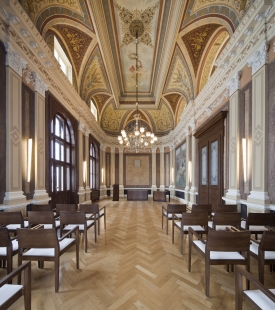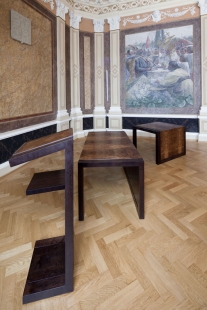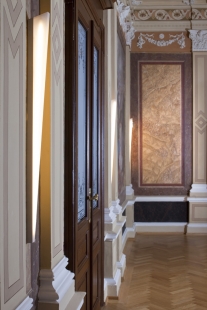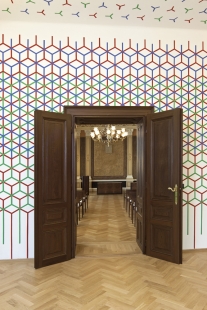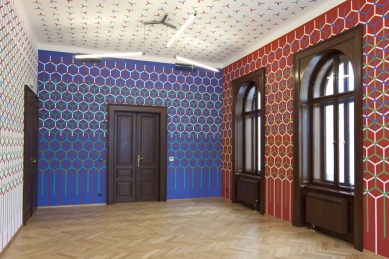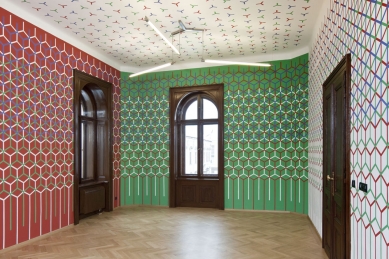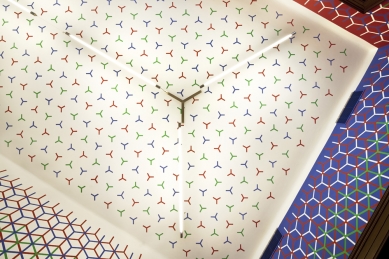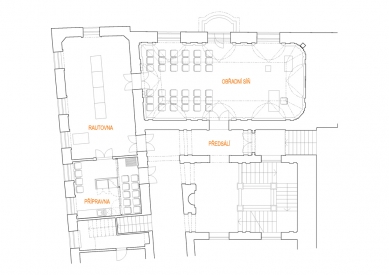
Revitalization of the ceremonial hall of the New Town Hall in Uherské Hradiště

The ceremonial hall in the building of the City Hall at Masaryk Square is a historic hall with plaster decoration and wall paintings by Joža Úprka, depicting events from the city's history. As part of the hall's refurbishment, the original wooden parquet floors were reconstructed, the casement windows were completely restored, and the balcony and interior doors were refurbished, where the original dark graining was restored according to the results of the conservation survey. The paintwork on the walls of the ceremonial hall was cleaned. The hall was furnished with new furniture, lighting elements, and air conditioning was installed in the space.
The assignment also included addressing the adjacent spaces of the hall and transforming them into a secondary hall (reception room) and a preparation area. When traces of the original paint were discovered during architectural historical surveys in the reception room (" ... deep green color with fragments of gilded and red decor."), the idea arose to bring them back to life. However, according to the survey, only fragments that did not correspond with the paintwork in the ceremonial hall were preserved. ("... according to traces on the walls, the older surface finishes were removed several times before new painting, and in many places, clearly younger plaster repairs can be seen. The technique of the older layers has no connection to the paintwork of the ceremonial hall.")
We were therefore faced with a decision - to reconstruct the hall as regular office spaces or to attempt to make it a distinct representative place that would connect to the ceremonial hall, fully respect it, and simultaneously communicate with it in a contemporary language.
Similar to Úprka, we drew inspiration from nature for this task, which influenced not only the painter, but also ordinary people, who from the beginning relied on it when building and decorating their homes, clothing, hairstyles, and items of everyday use. Thus, a distinctive expression emerged, which changed in connection with the landscape, tradition, and historical experience. Folklore.
We attempted to convey nature into the city's hall with modern forms. To let simple lines grow over the walls of the hall. To weave like the branches of trees, ending with a rich crown of leaves that flutter against the sun and spin in the wind as if they never wanted to fall to the ground, where a girl with braids in her hair runs away from well-dressed boys with Easter whips adorned with colorful ribbons. We tried to capture what Úprka before us depicted, and before him, those he portrayed in his paintings. Slovácko folklore, changing in form over time, yet still distinctive, expressive, and colorful.
Joža Úprka used the decoration in the ceremonial hall as a background for his paintings, capturing important historical milestones in the town's history. We could not and did not want to compete with the artistic or historical significance of these works. Our ambition was not to create an artwork that would compete with them. We attempted to create contemporary decoration inspired by them, thus creating a backdrop for new paintings - this time capturing important milestones of the present. Significant moments in the lives of the town's citizens, weddings, welcoming newborns, or important visits. These should be the living images that adorn this space.
The assignment also included addressing the adjacent spaces of the hall and transforming them into a secondary hall (reception room) and a preparation area. When traces of the original paint were discovered during architectural historical surveys in the reception room (" ... deep green color with fragments of gilded and red decor."), the idea arose to bring them back to life. However, according to the survey, only fragments that did not correspond with the paintwork in the ceremonial hall were preserved. ("... according to traces on the walls, the older surface finishes were removed several times before new painting, and in many places, clearly younger plaster repairs can be seen. The technique of the older layers has no connection to the paintwork of the ceremonial hall.")
We were therefore faced with a decision - to reconstruct the hall as regular office spaces or to attempt to make it a distinct representative place that would connect to the ceremonial hall, fully respect it, and simultaneously communicate with it in a contemporary language.
Similar to Úprka, we drew inspiration from nature for this task, which influenced not only the painter, but also ordinary people, who from the beginning relied on it when building and decorating their homes, clothing, hairstyles, and items of everyday use. Thus, a distinctive expression emerged, which changed in connection with the landscape, tradition, and historical experience. Folklore.
We attempted to convey nature into the city's hall with modern forms. To let simple lines grow over the walls of the hall. To weave like the branches of trees, ending with a rich crown of leaves that flutter against the sun and spin in the wind as if they never wanted to fall to the ground, where a girl with braids in her hair runs away from well-dressed boys with Easter whips adorned with colorful ribbons. We tried to capture what Úprka before us depicted, and before him, those he portrayed in his paintings. Slovácko folklore, changing in form over time, yet still distinctive, expressive, and colorful.
Joža Úprka used the decoration in the ceremonial hall as a background for his paintings, capturing important historical milestones in the town's history. We could not and did not want to compete with the artistic or historical significance of these works. Our ambition was not to create an artwork that would compete with them. We attempted to create contemporary decoration inspired by them, thus creating a backdrop for new paintings - this time capturing important milestones of the present. Significant moments in the lives of the town's citizens, weddings, welcoming newborns, or important visits. These should be the living images that adorn this space.
The English translation is powered by AI tool. Switch to Czech to view the original text source.
4 comments
add comment
Subject
Author
Date
Je to výmalba?
gallina-scripsit
09.02.10 07:38
ne
mufna
09.02.10 09:52
sponzor
10.02.10 02:49
re :sponzor
anarquitecto
02.03.10 06:54
show all comments


